Audi presented the RS e-tron GT Prototype in a CES Spotlight Session from the Audi Driving Experience Center racetrack in Neuburg, Germany, featuring a performance demonstration by Lucas di Grassi, Audi race team driver, FIA Formula E World Champion in 2016 and 2017, and a United Nations Environment Ambassador. It’s a four-door, fully electric, high-performance Gran Turismo (sport touring) car with a design that resembles the Audi A7, only sleeker. Its two-motor powertrain generates 475 kilowatts of power from an 800-volt system, resulting in 10,690 neuton-meters of torque at the wheels, said Siegfried Pint, head of powertrain development at Audi, who led the vehicle project for the past five years.
Though racetrack ready — with four-wheel steering as well as all-wheel drive — the car will be just as suitable for runs to the grocery store when it eventually comes to market, Pint added. It’s also the first battery-electric Audi based on a low floor architecture, making it 2.5-inches lower at the roofline than an A7, noted Marc Lichte, head of design at Audi, who led that aspect of the project.
BMW previewed the next generation of its iDrive infotainment system, which will be officially unveiled later this year and arrive first in the forthcoming iX battery electric vehicle (BEV). It will tap into the vehicle’s sensors and communicate with other BMWs and cloud-based services to receive and display hazard warnings and make predictions on the availability of parking spaces at a destination. The iX also will be the first BMW to feature a 14.9-inch curved high-resolution dashboard display that’s integrated with a 12.3-inch driver information display to form a single unit angled toward the driver. This year marks 20 years since BMW iDrive debuted in the 2001 model year BMW 7 Series. Production of the iX is slated to begin later this year for the 2022 model year.
FCA (Fiat Chrysler Automobiles) — now known as Stellantis N.V. following a merger with France’s PSA Group in late January — used CES’s digital venue to offer three-dimensional product tours and videos related to the automaker’s technologies and innovations in 12 vehicles. Virtual brand ambassadors guided viewers through sessions curated according to user preferences, or self-guided sessions. Technologies covered included FCA’s Uconnect 5 infotainment system, vehicle electrification systems, and vehicle performance and capabilities. A photo-realistic augmented reality (AR) model of the Jeep Wrangler 4xe plug-in hybrid-electric (PHEV) SUV was offered, enabled by Google’s cloud-streaming technology. Accessible via a QR code on FCA’s CES virtual showroom, for display on a mobile phone, it allowed viewers to place the rendered vehicle in a real-world place, such as a home’s driveway.
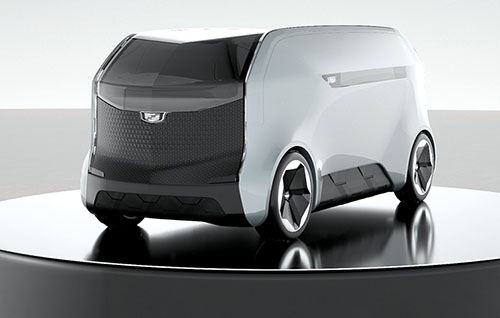
GM provided CES attendees with news incorporated into the opening night keynote of CEO Mary Barra, who was accompanied by company executives. The automaker is spending more than $27 billion through 2025 to develop EVs and self-driving cars, and in partnership with LG Energy Solutions is constructing a new battery cell manufacturing facility in Ohio.
One key building block for EVs presented was GM’s new Ultium platform, which enables nearly any vehicle to be electrified. It incorporates an almost completely wireless battery management system, which can work with horizontal or vertical stacks of six, eight, 10 or 24 battery cells (in vehicles sized from sports cars to large trucks), ensuring optimum performance and charging capacity.
Vehicles built on the platform will be able to achieve range of up to 450 miles per charge, the company said. It was also announced that Super Cruise, GM’s self-driving car system, will be brought to 22 vehicles by 2023, including the Chevrolet Bolt EV — which will be GM’s first EV to have this. More than 30 new EVs are planned for coming years, including a new Bolt EUV arriving this summer. GM also debuted Brightdrop, a new business unit that will sell electric commercial delivery vehicles built on the Ultium platform. These include EP1, an electric propelled pallet, that will be carried inside the new EV600 electric van. Both will be used by Fed-Ex, it was announced. The concept of a flying Cadillac passenger drone that resembled a hybrid car-helicopter was introduced, as well.
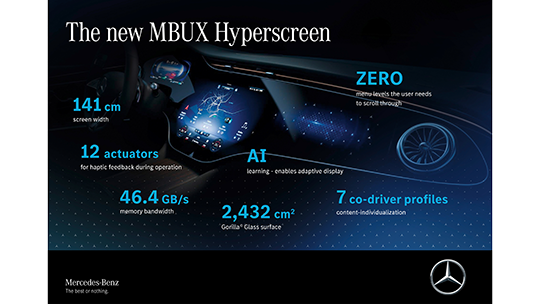
Mercedes-Benz featured its new MBUX Hyperscreen, a 55.5-inch single glass surface that contains three distinct displays for the driver, center-dashboard and front passenger. It’s based on the principle of a “zero-layer user interface,” which keeps the most important functions — such as navigation or telephone — always available on the top level, in the field of vision, explained Sajjad Khan, CTO of Mercedes-Benz AG, at a CES 2021 press conference streamed on January 11.
Artificial intelligence (AI) reveals more than 20 other functions, ranging from active seat massage choices to daily to-do list items if they’re deemed contextually relevant by the technology. Twelve actuators under the Hyperscreen surface provide haptic feedback. Eight GPU cores supplied by NVIDIA, 24 GB of RAM and 46.4 gigabytes per second RAM memory bandwidth hyper-accelerate system performance.
Sono Motors, a German startup, launched its next-generation Sion prototype, a solar-powered EV that uses polymer solar panels in the car’s body — dubbed Sono Solar Technology — to draw energy from the Sun. This paves the way for series production of the car, the company said. The automaker also revealed its first prototype of a solar-powered trailer, to demonstrate the technology’s utility for various vehicle types. Sono projects that the Sion will be affordably priced when it hits the market.
ADASKY showcased the latest generation of its VIPER thermal camera, which was named a CES 2021 Innovation Award Honoree. The camera has been upgraded with time-to-collision (TTC) software, allowing it to be a key component in automatic emergency braking (AEB) and forward collision warning (FCW) features of a vehicle’s advanced driver assistance system (ADAS). This generation of VIPER is expected to be built into cars coming to market in 2022, and automakers have shown interest in it for vehicles as far out as the 2026 model year, according to Bill Grabowski, head of North America for ADASKY, which is based in Yok’neam Illit, Israel. The previous generation of the VIPER was a CES 2020 Innovation Award Honoree.
Magna International Inc. announced at its CES 2021 press conference on January 11 a joint venture agreement with LG Electronics to manufacture e-motors, inverters and on-board chargers, plus related e-drive systems for select automakers. The result is a new company tentatively named LG Magna e-Powertrain. It will blend Magna’s strength in electric powertrain systems and automotive manufacturing with LG’s expertise in component development for e-motors and inverters, said Magna CEO Swamy Kotagiri. Separately, Magna also highlighted an expansion of its work with EV maker Fisker, to develop an ADAS for the Fisker Ocean SUV, expected to launch in late 2022. This will include a “unique, first-to-market” single-chip digital imaging radar technology named ICON RADAR that was co-developed with Uhnder, an Austin, TX-based startup.
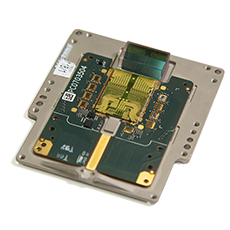 Intel’s Mobileye unit previewed its technology strategy to advance self-driving cars at a press conference on January 11. This includes bringing to market — in the 2024-2025 timeframe — a new generation of LiDAR using Intel’s silicon photonics technology, which can place both active and passive laser elements on a single chip. It’s called a photonic integrated circuit or PIC, said Mobileye CEO Amnon Shashua, adding that it will be offered to automakers in combination with a “cocoon” of software-defined imaging radars, as a cost-efficient solution for Level 4 self-driving cars.
Intel’s Mobileye unit previewed its technology strategy to advance self-driving cars at a press conference on January 11. This includes bringing to market — in the 2024-2025 timeframe — a new generation of LiDAR using Intel’s silicon photonics technology, which can place both active and passive laser elements on a single chip. It’s called a photonic integrated circuit or PIC, said Mobileye CEO Amnon Shashua, adding that it will be offered to automakers in combination with a “cocoon” of software-defined imaging radars, as a cost-efficient solution for Level 4 self-driving cars.
Source: Courtesy of MobilEye
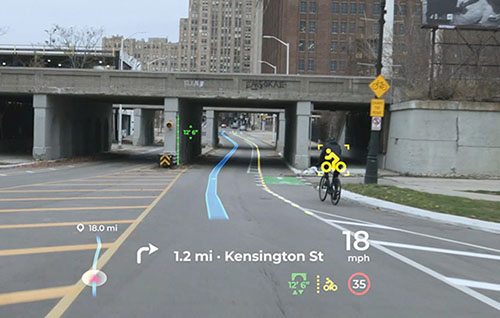
Panasonic Automotive Systems of America, at a CES press conference, introduced its new AR head-up display (HUD), which incorporates AI to render near-field and far-field content for vehicle information such as speed (near-field), object and pedestrian detection, and mapping and route guidance (far-field), in 3-D. Built-in eye-tracking technology assures that information is always line-of-sight with wherever the driver is looking, an integrated 3-D imaging radar sensor captures the scene 180-degrees forward and to a distance of 90 meters and across roughly three traffic lanes. The display resolution is 4K, from advanced laser holography technology by Envisics. “In comparison to a traditional HUD, an AR HUD will open up the windshield, interact graphically with the world and provide more intuitive information to the driver, who will no longer need to interpret warnings or alerts,” said Scott Kirschner, president of Panasonic Automotive and executive director of Panasonic Smart Mobility. “In a future with more self-driving vehicles, our AR HUD could provide an important added level of comfort and assurance for AV passengers as well.”
The all-digital CES 2021 provided a peek at what is coming in the auto industry. The future looks bright with promises of flying cars, electric sports cars, delivery robots and the latest technologies that make it all possible.
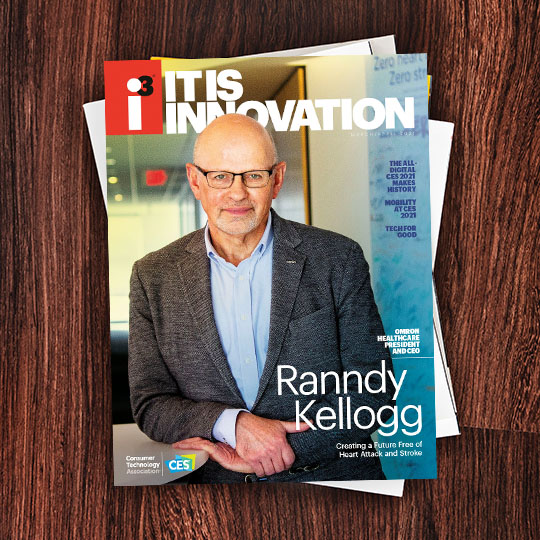
I3, the flagship magazine from the Consumer Technology Association (CTA)®, focuses on innovation in technology, policy and business as well as the entrepreneurs, industry leaders and startups that grow the consumer technology industry. Subscriptions to i3 are available free to qualified participants in the consumer electronics industry.